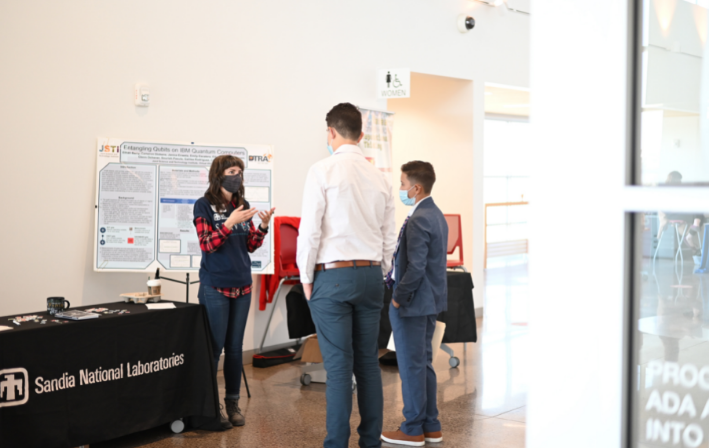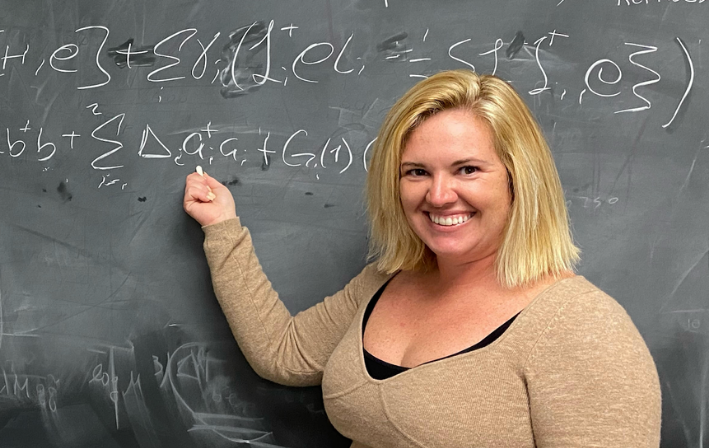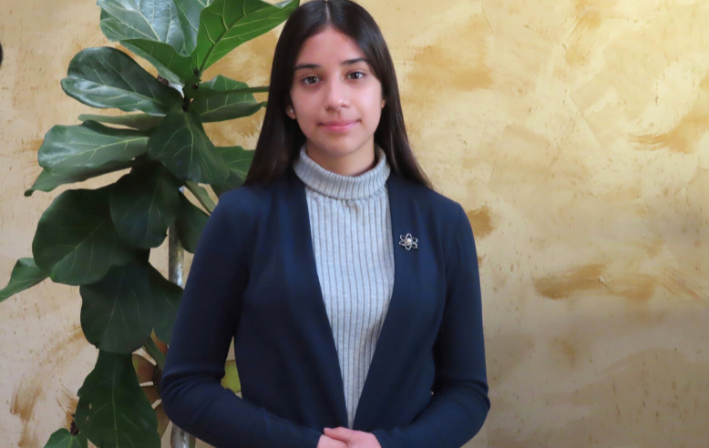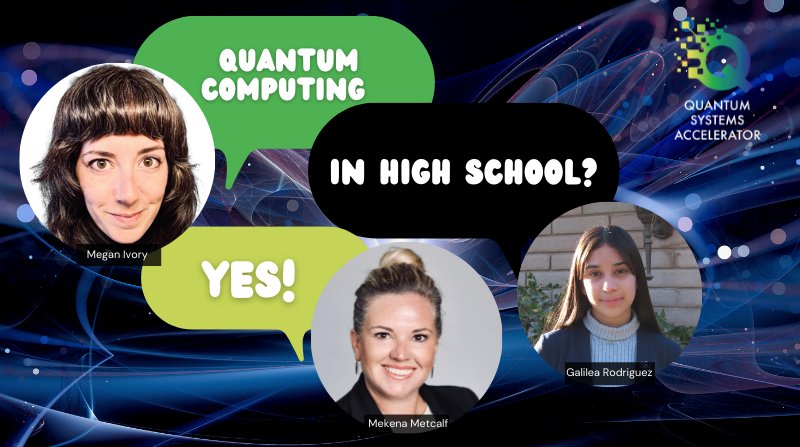The summer program was conducted virtually to inspire students without technical prerequisites to explore degrees in science, technology, engineering, and mathematics (STEM).
For the first-ever QIS pilot, ten students worked with nine QSA mentors from Lawrence Berkeley National Laboratory and Sandia National Laboratories. A robust educational curriculum was developed about the fundamentals, for example, from what is a quantum gate to how to run a quantum circuit on a quantum computer.
For many students, this program was their first exposure to QIS. Thanks to the engagement of the QSA mentors students also had the open opportunity to ask their questions about their careers directly to practitioners in the field.
One of the most exciting components of the summer program was the student-led research project in the second week. Students were able to build and study their first circuits on IBM’s cloud-based quantum computer. Furthermore, inspired by the premise of the U.S. television sitcom “The Office”, the cohort created a video about their QIS project for the JSTI summer program, winning first place in the student-led voting contest.
Representation Early in the Educational Journey
Sandia’s Megan Ivory, who serves as QSA’s program manager for JSTI summer mentorship, explained how there is a growing demand for a skilled and multidisciplinary workforce. However, the traditional pathways that recruit undergraduate and graduate students from the typical QIS adjacent fields such as engineering, computer science, and physics aren’t sufficient.


“Within our first year in QSA, we launched this summer pilot where we were able to teach high school students about quantum mechanics and quantum computing, thereby showing how often the young upcoming workforce is capable of grasping cutting-edge concepts. As a result, we’re already able to gauge impact and results.”
Going the Next Step: Collaborative Learning
Galilea Rodriguez, a junior at the Harmony Science Academy in El Paso, Texas, participated in the JSTI QIS track. Rodriguez shared how she’s always been curious about STEM, frequently participating in science fairs and competitions. Actively involved in many of her school’s extracurricular activities and events, including physics, rocketry, and college readiness, her interest in quantum mechanics grew after watching an online video by physicist Michio Kaku in middle school. She became even more interested in quantum computing throughout the JSTI program, so she reached out to Metcalf to expand her research in quantum teleportation.

“As a high school student,” explained Rodriguez, “it’s fascinating how I can learn more about quantum mechanics through quantum computing, which is really cool. Technology has developed so much over the years and now we’re entering a new realm in quantum information and science, and this could be the great leap we take to discover a great deal of information. This field can lead us into greater questions and themes.”
During the 2021-2022 winter break, Rodriguez met with Metcalf over Zoom a couple of times per week as she advanced in the direction of her research. During these meetings, Metcalf highlighted the scientific literature and relevant articles to support Rodriguez, while asking her about her hypothesis, methods, and experiment.
“I asked her many questions,” recalled Rodriguez, “even about the terminology I didn’t understand. Her answer to me was often a different question that got me thinking deeper about what I was learning about or pointing me to the literature where it was being used. This dynamic helped me figure things out on my own.”
For her research, Rodriguez studied three different quantum teleportation circuits that teleported entangled qubits in four different quantum devices to see how they affect each circuit’s final experimental error rate. She created three pairs of varying quantum teleportation circuits using Qiskit, an advanced open source software development kit (SDK) for programming quantum circuits and quantum processors.
Shortly after concluding her investigation, Rodriguez submitted both a research paper and presentation to the Sun Country Regional Science and Engineering Fair in El Paso. She won the fair’s first place in the category of Physics and Astronomy, and she won a first-place sweepstake allowing her to compete in the Texas Science & Engineering Fair and the Regeneron International Science & Engineering Fair. Rodriguez’s research was also recognized with the NASA Earth Systems Science Award, the Yale Science & Engineering Association Award, and the Office of Naval Research Award.
In the near future, Rodriguez sets her goals in continuing the self-guided research on something she discovered at the JSTI program: quantum scrambling (information scrambling like that theorized within black holes) and wormholes (the theoretical passages in space-time creating shortcuts to different locations in the universe). She plans to pursue QIS at college after she graduates in 2023.
Mentorship Is A Two-Way Relationship
QSA recognizes the profound impact of mentorships in the QIS ecosystem and how it prepares new generations of scientists and engineers as young as high school while positively influencing the scientific community.
Describing her reasons to lead the JSTI QIS program, Ivory added,
“I was the only female researcher in my graduate class, so I’ve been very fortunate throughout my career that being underrepresented in the field hasn’t really hindered me. However, I know that’s not always the case, so it’s been crucial for me to be able to push the dial in that regard to encourage other women and minorities to enter QIS. Second, before this summer pilot, I’d never actually taken a quantum computing course, so being able to teach myself and communicate these concepts well to the students has helped me grow as a scientist. I believe that until you communicate and discuss your research, your technical knowledge remains limited, so talking to high school students and hearing their questions and answers has helped me in my research.”
Metcalf shared her perspectives.
“Mentorship has really been invaluable in my career. I was heavily discriminated against and bullied in graduate school for being a woman in the field, but as I progressed in my professional journey, I made a lot of friendships and found mentors within the National Laboratories system, one of them being Dori Ellis, then executive director at the University of California Office of the President and later deputy labs director and chief operating officer at Sandia, which helped me push forward in my career. Experiencing first-hand how instrumental mentorships can be as a younger researcher, I have taken it upon myself to be a mentor. It is not just working towards my success but helping others like Galilea Rodriguez achieve their dreams and connecting them to the broader ecosystem. And from a technical standpoint, specifically, I learned a lot from her research and the implementation of the quantum teleportation circuit. This ultimately helped me when I presented the importance of quantum communication in a broader conference for senior scientists and engineers.”
Looking back at her experience, Rodriguez described the following,
“The opportunity at JSTI inspired me to continue building my knowledge in quantum computing and quantum mechanics, which I had already been curious about. I think the field is exciting, and there’s so much more that I want to learn. The extended mentorship with Dr. Metcalf was influential in guiding me in the right direction to aspire to learn more about quantum computing. I love the thrill of challenging myself to learn more and overcoming obstacles along the way. I’m very grateful for all the guidance and assistance. Competing at the international level has been my goal for as long as I can remember and after being able to find the right guidance, I can finally embark on a new journey.”
Q-Camp in 2022
For the 2022 summer session, Ivory is already leading the QSA efforts for a second pilot: Q-Camp (quantum computing, math, and physics) organized in tandem with the Computer Science for All Alliance, which will be tailored to high school students and teachers in New Mexico and California. High school students can register at https://bit.ly/qcamp2022.
“If we can equip high school teachers with the right tools to understand these quantum concepts to bring them into their classroom,” described Ivory, “we’re going to be able to reach a lot more students overall and have a deeper impact.”
Rodriguez advises her peers and other high school students across the nation to embrace the opportunity to expand their knowledge in QIS.
“I think it’s definitely great to start off small and build your way up little by little,” advised Rodriguez. “Sometimes the unknown world could be intimidating or scary, but also very thrilling. Once the spark of curiosity is ignited, then it becomes so hard to put it out. And when things become confusing, don’t be afraid to get lost in a rabbit hole of questions. Everybody learns differently and when we find ourselves in front of intimidating information, conquering it makes the journey that much more exciting. So let us indulge in our curiosities and not be afraid to expand our knowledge”
Founded in 1931 on the belief that the biggest scientific challenges are best addressed by teams, Lawrence Berkeley National Laboratory and its scientists have been recognized with 16 Nobel Prizes. Today, Berkeley Lab researchers develop sustainable energy and environmental solutions, create useful new materials, advance the frontiers of computing, and probe the mysteries of life, matter, and the universe. Scientists from around the world rely on the Lab’s facilities for their own discovery science. Berkeley Lab is a multiprogram national laboratory, managed by the University of California for the U.S. Department of Energy’s Office of Science. DOE’s Office of Science is the single largest supporter of basic research in the physical sciences in the United States, and is working to address some of the most pressing challenges of our time. For more information, please visit energy.gov/science.
Sandia National Laboratories is a multimission laboratory operated by National Technology and Engineering Solutions of Sandia LLC, a wholly owned subsidiary of Honeywell International Inc., for the U.S. Department of Energy’s National Nuclear Security Administration. Sandia Labs has major research and development responsibilities in nuclear deterrence, global security, defense, energy technologies and economic competitiveness, with main facilities in Albuquerque, New Mexico, and Livermore, California.
The Quantum Systems Accelerator (QSA) is one of the five National Quantum Information Science Research Centers funded by the U.S. Department of Energy Office of Science. Led by Lawrence Berkeley National Laboratory (Berkeley Lab) and with Sandia National Laboratories as lead partner, QSA will catalyze national leadership in quantum information science to co-design the algorithms, quantum devices, and engineering solutions needed to deliver certified quantum advantage in scientific applications. QSA brings together dozens of scientists who are pioneers of many of today’s unique quantum engineering and fabrication capabilities. In addition to industry and academic partners across the world, 15 institutions are part of QSA: Lawrence Berkeley National Laboratory, Sandia National Laboratories, University of Colorado at Boulder, MIT Lincoln Laboratory, Caltech, Duke University, Harvard University, Massachusetts Institute of Technology, Tufts University, UC Berkeley, University of Maryland, University of New Mexico, University of Southern California, UT Austin, and Canada’s Université de Sherbrooke. For more information, please visit https://quantumsystemsaccelerator.org/
